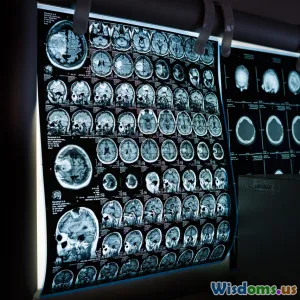
What Happens When Algorithms Predict Medical Outcomes
10 min read Explore how predictive algorithms transform medical outcomes and healthcare decision-making with real-world examples and potential impacts. (0 Reviews)
What Happens When Algorithms Predict Medical Outcomes
Introduction
Imagine visiting your doctor and instead of relying solely on tests and symptoms, they consult an intelligent algorithm that predicts your future health risks with remarkable accuracy. This is no longer science fiction—it’s the evolving reality in medicine today. Algorithms that predict medical outcomes are reshaping healthcare by providing insights into disease progression, treatment efficacy, and patient prognosis. But what exactly happens when these algorithms step into the clinical arena, and how do they influence lives?
This article delves into the fascinating intersection of technology and medicine, uncovering the power, potential pitfalls, and future directions of predictive algorithms in healthcare.
How Algorithms Predict Medical Outcomes
At the core, predictive algorithms in medicine analyze vast datasets—ranging from electronic health records (EHRs), genetic information, imaging results, and even lifestyle factors—to estimate patient risks or forecast disease trajectories. These models often use machine learning (ML) techniques including supervised learning, deep learning, and natural language processing.
Data Sources and Integration
A predictive algorithm's strength depends heavily on the quality and diversity of data. For example, combining clinical test results with wearable device data can provide insights into a patient’s real-time health status. Consider cardiovascular risk assessments: algorithms pull from blood pressure readings, cholesterol levels, family history, and even activity patterns measured by smartwatches to provide personalized risk scores.
Model Training and Validation
Algorithms are trained on historical data where outcomes are known—for example, patients who developed diabetes or had successful cancer treatments. The model learns patterns or markers associated with these outcomes, which it then applies to new patients. Validation with separate datasets ensures predictions remain accurate and unbiased.
Transformative Applications in Healthcare
Early Disease Detection and Diagnosis
One remarkable application is in the early detection of diseases such as cancer and Alzheimer’s. For instance, algorithms analyzing medical imaging have shown greater accuracy than human radiologists at identifying certain cancers at earlier stages. Google Health's AI model for breast cancer screening reduced false positives and missed diagnoses in studies published in Nature (2020).
Similarly, in neurology, ML models predict the likelihood of developing Alzheimer’s years before symptoms manifest by analyzing MRI scans and cognitive test data. Early interventions can then be applied, potentially delaying disease progression.
Personalized Treatment Plans
Predictive analytics helps optimize treatment effectiveness. Oncology has embraced algorithms to tailor chemotherapy regimens based on tumor genetics and patient-specific factors, reducing unnecessary side effects while improving outcomes.
Pharmacogenomics, where medication choices are informed by genetics, is another frontier heavily reliant on predictive models. Algorithms can forecast adverse reactions or treatment resistance, steering clinicians to safer, customized drug prescriptions.
Managing Chronic Conditions
Chronic diseases like diabetes and heart failure benefit from continuous monitoring and prediction. Algorithms analyze real-time patient data to forecast acute complications, prompting timely interventions. For example, machine learning models predict hospitalization risk for heart failure patients, reducing readmission rates significantly in pilot programs.
Operational and Resource Forecasting
Beyond individual care, hospitals use predictive algorithms to manage resources efficiently—anticipating patient influx, optimizing staff allocation, or predicting equipment demand. This operational intelligence improves healthcare delivery quality, especially during emergencies like the COVID-19 pandemic.
Challenges and Ethical Considerations
Data Bias and Equity
A critical challenge lies in the representativeness of training data. If algorithms are trained with data skewed towards a specific demographic, predictions may underperform or mislead for minority populations, exacerbating health disparities.
For example, pulse oximeters have been found less accurate in people with darker skin tones—a flaw potentially magnified by biased algorithmic models relying on such data.
Transparency and Trust
Clinicians and patients need to understand algorithmic recommendations. Many models, especially deep learning networks, operate as “black boxes,” making it difficult to interpret why certain predictions are made. This opacity can hinder trust and clinical adoption.
Privacy and Data Security
Medical data is highly sensitive. Ensuring patient privacy while collecting and processing massive datasets for algorithm training is paramount. Regulations like HIPAA (US) and GDPR (Europe) strive to protect this data but also pose hurdles for data accessibility.
Clinical Integration and Workflow
Algorithms must seamlessly integrate with existing clinical workflows. Overloading healthcare providers with alerts or complex tools can detract from patient care. Successful systems balance predictive power with simplicity and actionable recommendations.
Real-World Insights and Examples
IBM Watson for Oncology
IBM’s Watson was hyped as a revolutionary AI system to recommend cancer treatments based on literature and patient data. While promising in trials, clinical adoption revealed limitations: inconsistent results, difficulty in integrating local protocols, and clinician skepticism. It exemplifies the challenges of translating algorithms into practice.
Sepsis Prediction Models
Sepsis, a rapid and deadly infection, benefits hugely from early detection. Epic Systems' sepsis prediction tool deployed in several hospitals uses real-time EHR data to flag high-risk patients, reportedly reducing mortality rates. This success underscores the life-saving potential when predictions are timely and trusted.
Google's DeepMind and Eye Disease
In partnership with Moorfields Eye Hospital, DeepMind developed an algorithm to interpret optical coherence tomography scans for eye diseases. Achieving accuracy on par with experts, it holds promise for wider accessibility of specialized diagnostics, especially in underserved regions.
The Future of Predictive Algorithms in Medicine
Integrating Multi-Omics and Environmental Data
Future predictive models will likely integrate genomic, proteomic, metabolic data together with environmental and social determinants of health, building a holistic patient profile. This could revolutionize precision medicine and public health interventions.
Adaptive and Continual Learning Systems
Unlike static models, adaptive algorithms will evolve with new incoming data, reflecting changing disease patterns or treatment responses in real time. This dynamic approach may improve long-term accuracy and personalization.
Collaboration Between AI and Clinicians
The future will emphasize “augmented intelligence” rather than AI replacing doctors. Algorithms will serve as decision-support tools, enhancing human expertise rather than supplanting it.
Regulatory and Ethical Frameworks
Developing clear guidelines ensuring safety, fairness, transparency, and accountability of predictive systems will be crucial. Initiatives like the FDA’s AI/ML-Based Software as a Medical Device (SaMD) regulatory framework demonstrate progress in this area.
Conclusion
Algorithms predicting medical outcomes have already begun to transform healthcare, evidenced by improved diagnostics, personalized treatments, and better operational planning. Yet, as we embrace this technology, we must navigate ethical concerns, data quality issues, and integration challenges cautiously. With deliberate development and interdisciplinary collaboration, predictive algorithms hold promise to profoundly enhance patient outcomes, ushering in a new era where data-driven medicine complements human care. This evolving journey challenges us to rethink how we diagnose, treat, and ultimately, how we envision the future of health itself.
As Dr. Atul Gawande insightfully noted, "Better information and more human empathy work best together." Algorithms predicting medical outcomes provide the information; it’s up to the medical community to harness this power with empathy and wisdom.
Rate the Post
User Reviews
Popular Posts



















